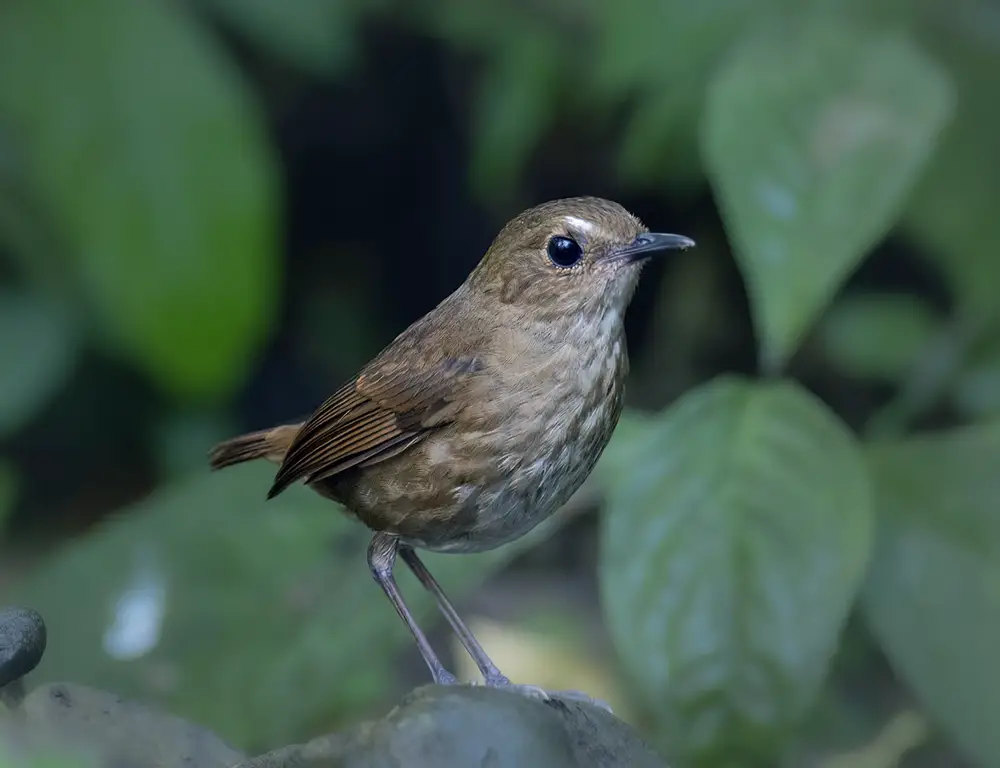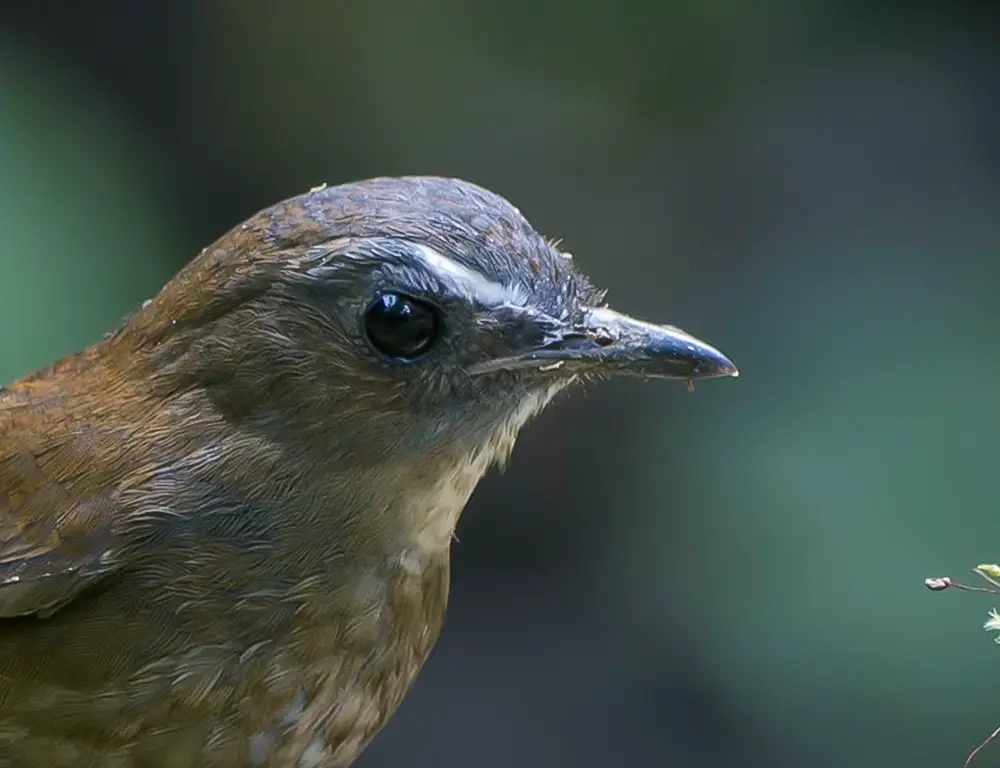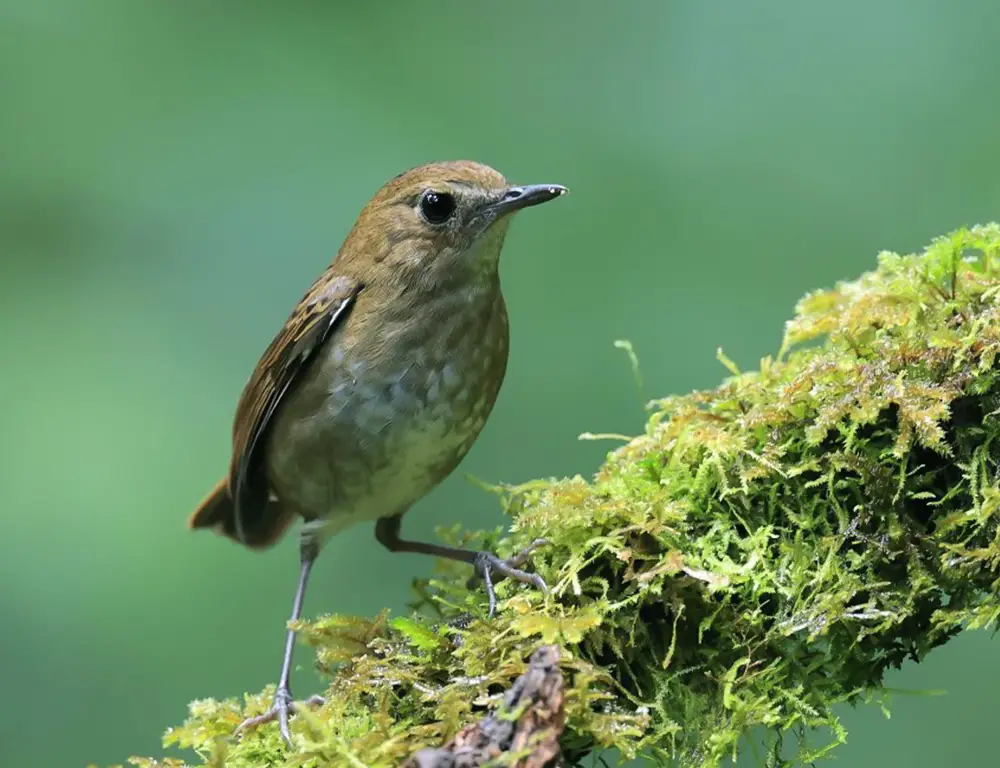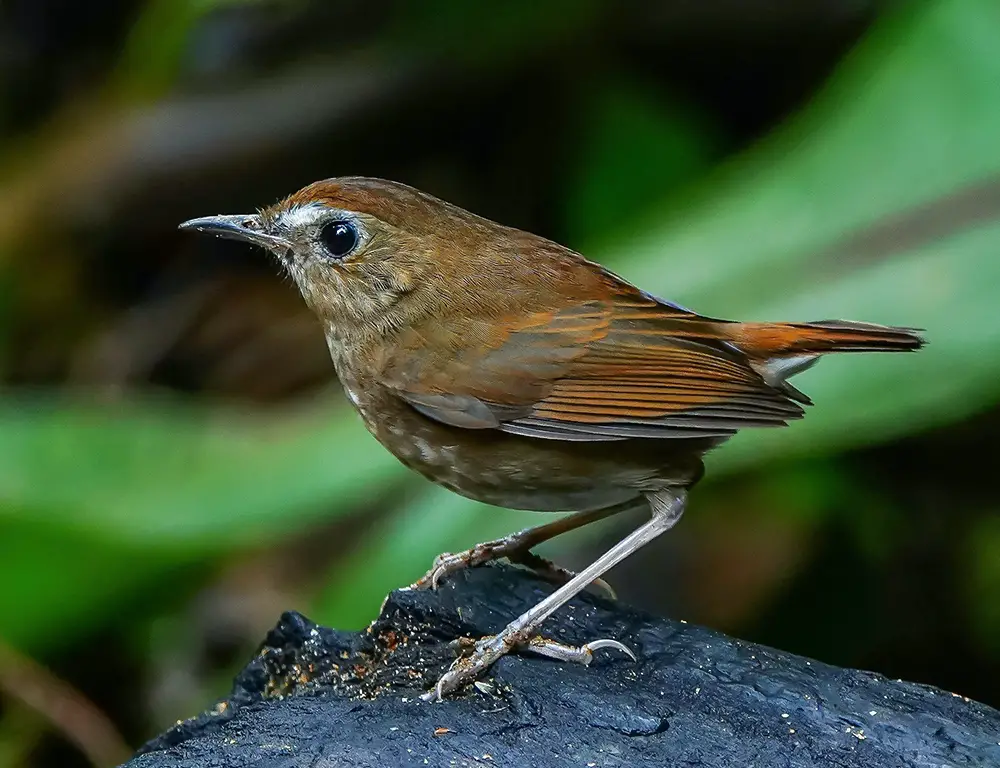Nestled within the dense undergrowth of Southeast Asia’s sprawling rainforests resides a hidden treasure: the Lesser Shortwing. With its distinct short wings and earthy-colored plumage, this elusive bird captivates with its mystery and charm.
Despite its unassuming appearance, the Lesser Shortwing’s mastery of camouflage renders it a true adaptation marvel, seamlessly blending into its forest habitat. Beyond its expert concealment, its enchanting melodies reverberate through the forest, a testament to its allure.
As a devoted observer of these remarkable songbirds, I’ve been captivated by their secretive lifestyle and the endless fascination they inspire. Join me on a journey into the captivating world of the Lesser Shortwing, where every discovery unveils a new layer of intrigue and wonder.

Habitat and Distribution of the Lesser Shortwing
The Lesser Shortwing (Brachypteryx leucophrys) is a small bird species native to the dense forests of Southeast Asia.
Here’s an overview of its habitat and distribution:
Preferred Habitat
The Lesser Shortwing is primarily found in subtropical or tropical moist lowland and montane forests. It has a particular affinity for dense undergrowth within bamboo forests.
These habitats provide the bird ample cover and a rich diversity of insects, constituting its primary food source.
The Lesser Shortwing prefers altitudes ranging from 800 to 1900 meters above sea level but has been observed at higher elevations up to 3300 meters, especially during summer migrations.
Geographic Distribution
The Lesser Shortwing’s range extends across various countries in Southeast Asia, including:
- Northeast India: This region includes states such as Assam, Arunachal Pradesh, Meghalaya, and Nagaland, where suitable habitats exist for the species.
- Southeast Asia: Countries like Myanmar, Thailand, Laos, Cambodia, Vietnam, and Malaysia host populations of Lesser Shortwings, primarily in forested areas.
- Indonesia: The species is also found in parts of Indonesia, including Sumatra, Java, Borneo, and Sulawesi, where suitable habitats exist.
- Papua New Guinea: Besides Southeast Asia, Lesser Shortwings inhabit parts of Papua New Guinea, particularly in montane forests.
Physical Characteristics of the Lesser Shortwing
The physical characteristics of the Lesser Shortwing contribute to its adaptation to its forest habitat and unique ecological niche.
Here’s an overview of its key physical traits:
Size
The Lesser Shortwing is a small bird, typically measuring between 11 to 13 centimeters (approximately 4.3 to 5.1 inches) in length. This compact size allows it to navigate through dense undergrowth and foliage with agility.
Shape
It has a stout and compact body with short wings, reflected in its name. The short wings adapt to its ground-dwelling lifestyle, allowing it to maneuver effectively within the dense vegetation of its habitat.
Plumage
The plumage of the Lesser Shortwing varies between genders and age groups. Males typically have bluish-gray upperparts with paler underparts, while females exhibit brownish-gray feathers.
This coloration provides effective camouflage against the forest floor, helping the bird to blend in with its surroundings and avoid predators.
Beak

The Lesser Shortwing has a relatively short, pointed beak, which it uses to forage for insects and other invertebrates in leaf litter and soil. The sharp beak lets it probe and peck at the forest floor precisely, extracting prey items from crevices and debris.
Legs and Feet
It has strong legs and feet, well-suited for hopping and perching on the forest floor. These adaptations enable the Lesser Shortwing to move quickly and efficiently through its habitat and grasp and manipulate prey items during foraging.
Behavioral Characteristics
While not strictly physical, the behavior of the Lesser Shortwing complements its physical characteristics. It is primarily a ground-dwelling bird, spending much time foraging for insects and other invertebrates among leaf litter and vegetation.
Its compact size, short wings, and camouflaged plumage are all adaptations that enhance its survival in this environment.
Behavior and Diet of the Lesser Shortwing
The behavior and diet of the Lesser Shortwing shed light on its unique ecological niche and lifestyle within the forest ecosystem. Here’s an overview:
Behavior

The behavior of the Lesser Shortwing, a small bird species native to Southeast Asia, is fascinating and well-adapted to its forest habitat. Here’s an overview of its behavior:
Ground Foraging
The Lesser Shortwing is primarily a ground-dwelling bird, spending much time foraging on the forest floor. It hops and moves adeptly among leaf litter, fallen branches, and low vegetation for food.
Territorial Behavior
During the breeding season, males exhibit territorial behavior, defending their territories through vocalizations and occasional displays. They may interact aggressively with intruding males to protect their mating territory.
Courtship Displays
Males engage in elaborate courtship displays to attract females. This may include singing complex songs consisting of high-pitched whistles and fluttering around potential mates in a ceremonial dance.
Nesting
Lesser Shortwings construct their nests on the ground, typically under dense vegetation or amid leaf litter cover. Both male and female birds participate in nest-building activities, using leaves, grasses, and other plant materials to construct a well-hidden and camouflaged nest.
Parental Care
After mating, the female lays eggs (usually two per clutch), which she incubates alone while the male stands guard nearby. Both parents contribute to feeding and caring for the chicks after hatching.
Diet
The diet of the Lesser Shortwing primarily consists of small invertebrates, with a particular focus on insects. Here’s a closer look at its dietary habits:
Insectivorous
The primary diet of the Lesser Shortwing consists of insects and other invertebrates found on the forest floor. They feed on small prey, including beetles, ants, spiders, caterpillars, and insect larvae.
Ground Foraging
Lesser Shortwings employ a ground-foraging strategy, using their strong legs and sharp beaks to probe and peck at leaf litter and soil in search of hidden prey. They may also glean insects from low vegetation or fallen branches.
Supplementary Foods
During times when insect abundance is low, such as colder months or breeding seasons, Lesser Shortwings may supplement their diet with seeds, berries, and other plant matter found on the forest floor.
Conservation Status of the Lesser Shortwing

The conservation status of the Lesser Shortwing is a matter of concern due to various threats facing its habitat and populations.
Here’s an overview of its conservation status, including threats and conservation efforts:
Threats
Like many other bird species, the Lesser Shortwing faces several threats to its survival. Here are some of the main threats to the Lesser Shortwing:
Habitat Loss and Degradation
Deforestation, primarily driven by logging, agricultural expansion, and infrastructure development, poses a significant threat to the Lesser Shortwing’s habitat.
The conversion of forests into agricultural land or human settlements results in the loss of crucial habitat for the species, reducing available nesting sites and foraging areas.
Fragmentation
Habitat fragmentation further exacerbates the impact of habitat loss by isolating populations and reducing connectivity between forest patches.
Fragmented habitats may lead to reduced genetic diversity, increased vulnerability to environmental disturbances, and limited dispersal opportunities for the species.
Human Disturbance
Human activities such as tourism, recreational activities, and infrastructure development in forested areas can disturb nesting sites, disrupt breeding behavior, and cause stress to Lesser Shortwing populations.
Increased human presence in their habitats may also lead to disturbance during critical life stages, such as nesting and foraging.
Climate Change
Climate change can alter the distribution and abundance of suitable habitats for the Lesser Shortwing. Changes in temperature and precipitation patterns may affect the availability of food resources, breeding success, and overall population dynamics of the species.
Conservation Efforts
Conservation efforts aimed at protecting the Lesser Shortwing and its habitat are crucial for ensuring the long-term survival of this species. Here are some conservation initiatives and strategies focused on safeguarding the Lesser Shortwing:
Habitat Protection and Restoration
Conservation organizations and government agencies are working to establish protected areas and conservation reserves to safeguard critical habitat for the Lesser Shortwing.
Efforts to restore degraded habitats through reforestation and habitat rehabilitation projects aim to enhance habitat quality and connectivity for the species.
Community Engagement
Engaging local communities in conservation initiatives is crucial for promoting sustainable land-use practices and reducing human impacts on the species’ habitat.
Community-based conservation programs involve local stakeholders in habitat monitoring, ecological restoration, and sustainable livelihood activities that benefit both people and wildlife.
Research and Monitoring
Ongoing research efforts focus on understanding the ecology, behavior, and population dynamics of the Lesser Shortwing. Monitoring programs track population trends, habitat changes, and threats to effectively inform conservation strategies and management decisions.
Policy Advocacy
Advocacy efforts aim to raise awareness about the conservation status of the Lesser Shortwing and advocate for policies and regulations that protect its habitat and mitigate threats.
Collaboration between governments, conservation organizations, and local communities is essential for implementing effective conservation measures and ensuring the species’ long-term survival.
Conclusion
Though small in size, the Lesser Shortwing possesses remarkable survival skills and unique traits that set it apart. Its ground-based lifestyle, melodious song, and effective camouflage highlight its adaptability to dense forest environments.
Conservation efforts are crucial to safeguarding its habitat against deforestation and human encroachment threats. Yet, gaps in understanding remain, emphasizing the need for further research to ensure its preservation.
With increased awareness and concerted conservation efforts, there’s hope for the future of the Lesser Shortwing. Together, we can ensure that this elusive bird continues to enchant future generations with its presence in the intricate tapestry of our forests.